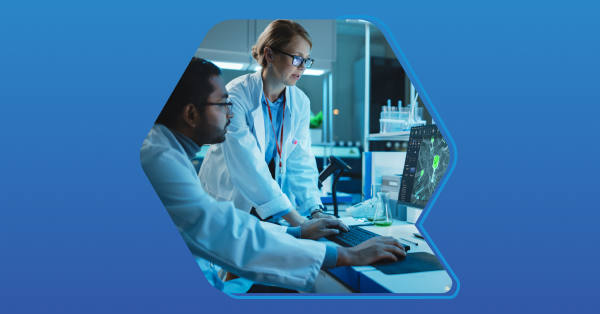What is a LIMS?

For all the sophisticated work that labs do, many are one deleted spreadsheet or soggy notebook away from disaster.
We’ve worked with several cutting-edge labs over the years. Whether it’s transporting kidneys across the country or providing necessary testing to support the food industry, these labs are all doing incredible work, but have one thing in common: they are held hostage to their data and kept back by their manual systems.
How about your lab?
When the FDA shows up next month, how long will it take you to prove that Sample #4,847 was processed according to SOPs with properly calibrated instruments? If that question makes you feel uncomfortable, you already know you need a LIMS. The only question is whether you'll implement one before the audit or after the violation notice.
In this guide, we’ll share what a LIMS is, practical examples of how it can benefit your lab, and how to choose the best one. Read on, or bookmark this guide to save for later!
LIMS Basics: What is a LIMS?
LIMS is an acronym that stands for Laboratory Information Management System.
In non-software terms, a LIMS is a comprehensive software platform that manages data, generates reports, and automates processes.
The need for data and process management is nothing new for labs. For decades, labs have made do with manual and paper-based systems. Manual recordkeeping worked when labs processed 50 samples a week. Today, high-throughput labs routinely handle hundreds or thousands. Add regulations like 21 CFR Part 11, and suddenly your spreadsheet isn’t inefficient, it’s non-compliant.
That’s where a LIMS comes in handy.
At their core, all LIMS are software platforms that manage and track samples, data, and workflows and integrate other software and instruments. From sample intake and disposal to inventory input and re-ordering, a LIMS serves as a digital system of record, giving your lab accurate and up-to-date information – something especially useful when the FDA pays a visit.
This data management and reporting shoulders the cognitive load that comes with managing information and processes, freeing labs up to scale their throughput or expand. This isn’t just marketing-speak about hypothetical benefits; it’s been proven that the efficiencies driven by a LIMS can result in 30% reductions in some laboratory development timelines.
Let’s explore the finer points of functionality in this sophisticated platform.
What Can a LIMS Do?
As we’ve shared above, a LIMS is a comprehensive data management and automation platform for labs – that’s great in theory, but let’s get practical.
There are a few key functions of a LIMS that apply to most labs:
- Data management
- Workflow management
- Reporting
- Compliance
How a LIMS Helps With Data Management
Data management refers to the robust set of features that a LIMS provides to manage the inflow of items entering and leaving your lab. This includes things like:
- Track samples: A LIMS can be used to track the entire sample lifecycle from receipt to disposal. Rather than write things down in a notebook, you can scan items that enter your lab (via barcode scanning) and automatically track items that move through your lab.
- Manage chain of custody: Automated logging and tracking make it simple to set up and maintain a chain of custody program in your lab, giving you a bird’s eye view of where every sample is.
- Manage and replenish inventory: A LIMS can be used to manage inventory. By logging usage and tracking expiration dates, you can ensure that no inventory goes to waste in your lab. By setting up low-stock alerts or even automatic re-ordering, you can avoid slowdowns as well.
- Review and manage tests at scale: A LIMS can be used to monitor the quality of test results and proactively prevent downstream errors by automatically flagging any abnormal or out-of-range results and alerting your staff to take corrective action.
A LIMS does more than manage and track data (even an ELN can do that). It can also be used to automate processes in your lab, which we’ll cover next.
How a LIMS Helps With Workflow Management and Automation
Automation is where a LIMS separates itself from the rest of your lab software options. A LIMS can be used to automate key processes in your lab, reducing the amount of busy work and manual data entry you need to do and freeing your staff up for more important tasks.
Here’s a sample of what you can automate with a LIMS:
- Automatic re-run flagging when results fall outside QC thresholds
- COA generation and distribution upon test completion
- Sample registration
- Data analysis
- Create schedules for routine tasks such as sample preparation or equipment maintenance
- Calibrate instruments and flag issues.
And that’s just the start! If there is a process your staff routinely needs to run manually, chances are it can be automated with the right LIMS (more on this later). Note: not all LIMS treat automation equally. Some require custom code to make changes, which can increase complexity over time. Others, like QBench, take a configurable approach to automation that empowers your staff (no matter how technical) to make changes as your needs and workflows evolve.
How a LIMS Helps with Reporting
Need to send a custom COA, a Chain of Custody report, or a CSV export for your client’s ERP? A LIMS can automate those builds without the need for templates or copy/paste.
Thanks to no-code report builders, you can automate COA reports, build EDD templates, and more to save time and streamline your reporting processes. A LIMS can virtually eliminate the need for manual data entry and report building.
How a LIMS Helps with Compliance and Regulations
All of this is well and good, but where a LIMS proves to be a cut above comes with its compliance support.
Without automated software like a LIMS, it is up to your staff to manage and track down every scrap of paper or reams of spreadsheet to meet compliance guidelines. One lab we spoke with that needed to meet stringent FDA standards in the cosmetics industry managed QA/QC entirely by hand. The process was so laborious and scattershot that they described their notebooks as “so disgusting no auditor would want to touch them.”
Having a LIMS automate data capture and retrieval can support GxP (Good Laboratory Practices), 21 CFR Part 11, ISO 17025 standards, and more through features like:
- Record keeping
- Audit trails
- Data backups
- Role-based access
- SOP and document management
- Electronic signatures
- Real-time monitoring of processes
- Support for CAPA
Learn more in our security and compliance center!
The Top Benefits of Using LIMS in Your Lab
When people talk about LIMS benefits, they usually rattle off words like "efficiency" and "productivity." But if you’ve ever tried to retrieve a test result from three years ago, only to find it buried in a corrupted spreadsheet, you know these aren’t just buzzwords.
Here’s what actually changes when you replace your patchwork of notebooks, Excel files, and tribal knowledge with a well-implemented LIMS:
- Increased efficiency
- Improved data accuracy
- Enhanced collaboration
- Better decision making
- Increased productivity
Increased Efficiency
Imagine what you can accomplish by ditching notebooks and spreadsheets.
With automation and workflow mapping, you could double the number of daily samples processed, just as one lab did at the height of the COVID-19 testing crunch. When you’re limited by your staff and held back by your systems, increasing throughput could be the nail in the coffin when it comes to managing data compliantly.
By reducing manual intervention, your lab can focus on more complex tasks, thereby increasing overall throughput. For more efficiency tips, check out our guide to 6 ways a LIMS can make your lab more efficient.
Improved Data Accuracy
Say goodbye to the pit in your stomach when the FDA asks for an explanation behind a test result or asks you to look up a record.
With a LIMS, manual data entry becomes a thing of the past, speeding up your staff and boosting data integrity in the process. Manual data entry is prone to errors and can be time-consuming. By automating this process, LIMS reduces the likelihood of human error. By eliminating tedious manual data entry, you could join the 90% of users for whom a LIMS improves data integrity.
This also makes data retrieval a trivial matter, as you can easily search records, samples, and inventory in seconds. This accuracy is crucial, especially in fields requiring stringent documentation and compliance with regulatory standards.
Enhanced Collaboration
As teams grow and become more distributed, you must select a platform that allows for secure collaboration no matter where your people are . We've seen instances where different scientists were updating multiple versions of the same sample tracking spreadsheet. The result? Data integrity failures and lost samples.
Fifty percent of preclinical data can’t be reproduced. Because the problem costs billions annually, you could save money and share data better with LIMS.
Better Decision Making
A LIMS provides a centralized data management solution that enhances decision-making capabilities. With accurate and readily accessible data, managers and scientists can make more informed decisions. You could use your enhanced, centralized data to make business decisions and become 1.5 times as likely to report high revenue growth of over 10%.
Increased Productivity
The automation features of LIMS extend beyond just processing efficiency. They also significantly impact overall productivity. By automating routine tasks, LIMS frees up staff to focus on critical, high-value activities.
Use automation to free workers’ time for mission-critical tasks. Reduce manual steps by 80% and lower turnaround time while you’re at it. Check out our guide to automating your lab with a LIMS for our best ways to streamline and automate your lab.
What are the Types of LIMS?
While the LIMS market is catching fire in this decade, the concept of a LIMS is not exactly new to labs.
Before today’s modern, cloud-based software, labs may have installed LIMS software via a hard drive or built one that was hosted on their servers. Today, the LIMS market has evolved, giving you a diverse number of options to choose from. The top three you will come across are:
- Client-server/On-prem
- Web-based
- Cloud-based
Client-Server/On-Prem LIMS
Before software was hosted on the cloud, it was up to in-house teams to manage it on their own servers. These types of software platforms have persisted, though cloud-based software certainly is the first thing that comes to mind when you think of “software.”
Custom-built LIMS work best for larger laboratories with a dedicated IT department and the resources to maintain an on-premises (on-prem) server. An on-prem LIMS provides more control over data, is highly customizable, and can be tailored to meet specialized lab requirements. That said, it comes with a higher price tag to maintain, puts the onus for security on your lab, and could lock you into existing workflows unless you have development resources to make changes as your needs evolve.
Web-Based LIMS
Taking a step further into the modern era of software, we have a web-based LIMS.
A web-based LIMS may sound like a cloud-based LIMS, but there is a key distinction between the two. Both web-based and cloud-based software are accessed via the internet and a browser, but a web-based LIMS may not always leverage cloud infrastructure and data storage.
Still, a web-based LIMS is flexible and accessible, making it ideal for smaller labs requiring remote data access from multiple locations. It’s hosted on a web server, allowing labs to control their data on-prem with fewer IT resources than a client-server LIMS.
Cloud-Based LIMS
Most new software platforms are cloud-based, and for good reason: cloud-based software gives your lab access to fully managed and up-to-date software with no effort on your part beyond logging in and using it.
A cloud-based LIMS is hosted on a remote server, giving you access to your lab’s data without the overhead of managing it. Cloud-based software is scalable, allowing you to manage more data and users as your lab grows without the need for storage constraints.
Many cloud-based software companies invest heavily in innovation as well, meaning you’ll benefit from new features each quarter or even month!
How Does a LIMS Compare to Other Popular Lab Software Platforms?
A LIMS is not the only software platform available to labs to digitize their processes or manage data. Commonly, labs may start with one of the following or use them in conjunction with a LIMS:
- ELN
- LIS
- ERP
LIMS vs ELN
An ELN (Electronic Lab Notebook) is often the first step labs take to digitize their workflows.
An ELN serves as a digital version of what a physical lab notebook provides. You can manually input data into an ELN and record notes and observations from tests; however, ELNs don’t offer the same reporting and automation capabilities as a LIMS.
While a LIMS and an ELN play essential roles in streamlining a lab's operations, they serve distinct functions. A LIMS is best suited for:
- Managing samples and test data.
- Automating lab workflows.
- Generating reports.
- Integrating lab instruments.
- Providing support for inventory and billing management.
Many laboratories benefit from using a LIMS alongside an ELN to completely digitize their operations and data. If you need more than a digital record and source of truth, then a LIMS is a better choice for your lab than relying solely on an ELN.
Learn more about the differences between a LIMS and an ELN.
LIMS vs LIS
LIS stands for “Laboratory Information System.” The only word missing from the name is “management,” so how different could these platforms be?
It turns out, by quite a lot.
A LIS is a specialized software platform primarily used in medical and clinical laboratories. A LIS is designed to manage patient data, test orders, and results, ensuring seamless integration with Electronic Health Records (EHR) systems.
Like a LIMS, a LIS stores and manages information for a lab. However, a LIS is specialized to store:
- Patient data management
- Test ordering and scheduling
- Results reporting and delivery
- Billing and insurance processing
- Compliance with regulatory standards (e.g., HIPAA, CLIA)
A LIS plays an important role in streamlining the workflow of medical labs, enabling faster and more accurate diagnoses and treatment decisions. For labs that operate outside the clinical realm, a LIMS is a better choice. Clinical labs may still benefit from using a LIMS alongside a LIS, though. Learn more about the differences between a LIMS and a LIS.
LIMS vs ERP
An ERP (Enterprise Resource Planning) is a software platform designed for general business management, not specifically for laboratories. These tools excel at connecting finance, HR, and supply chain operations across an organization, but weren't built with scientific workflows in mind.
An ERP is somewhat similar to a LIMS, as it can help automate processes and workflows, but unlike a LIMS, an ERP is designed with a generic business purpose in mind rather than lab-specific needs.
ERPs can be particularly valuable for larger organizations, where the complexity of operations can make maintaining consistency and efficiency across departments challenging. If you're considering an ERP, be forewarned: Gartner estimates that 55% to 75% of all ERP projects fail to meet their objectives, and a large percentage of ERP implementations go over budget, according to Statista.
ERPs can be useful, but serve a much broader purpose than a LIMS. As a result, ERP will be more difficult to configure to meet your lab’s niche needs. Learn more about the differences between a LIMS and an ERP.
How to Choose the Right LIMS for Your Lab
Once you’ve settled on a LIMS, it’s time to make sure you choose the right one for your lab.
This is an exhaustive topic on its own, so we’ll make it brief. We recommend taking the following approach:
- Evaluate your lab’s needs
- Determine the type of LIMS you require
- Consider the balance of features and cost
Let’s walk through these in a bit more detail.
Evaluate Your Lab’s Needs
First, evaluate your organization's needs and determine whether an off-the-shelf LIMS can meet them.
- What is your average sample volume per week?
- Do you need to support remote or multi-site teams?
- What are your regulatory obligations (e.g., GxP, ISO 17025, HIPAA)?
- How often do your workflows change?
Remember, you’ll have multiple options to configure and customize any LIMS, but it’s helpful to map out your needs first before locking your lab into a longer-term contract with the wrong vendor.
Determine the Type of LIMS You Need
Refer to the list above to determine which type of LIMS you need:
- On-premise
- Web-based
- Cloud-based
For large enterprise labs with data sensitivity concerns and ample budget for self-hosting software, an on-premise LIMS could do the trick. For labs with limited budget and bandwidth to manage and update software themselves, a cloud-based LIMS is often the best option.
Consider the Balance of Features and Cost
Weigh each option's benefits and drawbacks, including the customization level, integration with existing systems, and ongoing maintenance.
No matter the type, LIMS need regular testing to ensure they’re functional and accurate. Use automated testing tools to cover interfaces, workflows, and data management capabilities. Testing can help identify and resolve issues before they impact the accuracy of laboratory results.
For more information, check out our comprehensive guide to selecting the right LIMS.
How to Implement a LIMS
You’ve selected a LIMS, so the work is done, right?
Not quite. Like any software, a LIMS will need to be implemented for your team to set your lab up for success and ensure things are working properly.
The implementation time of a LIMS varies widely depending on several factors, including:
- The size and complexity of the laboratory.
- The specific features required.
- The LIMS vendor's implementation process.
While the steps to implement a LIMS will vary from lab to lab, you can expect the following essential steps when implementing a LIMS like QBench:
- A kick-off call: This sets the stage for a successful implementation that allows your lab to hit the ground running.
- Settings and configuration setup: We’ll review product configuration options, statuses, and custom fields in QBench to ensure you are ready to receive the data for your workflows.
- A review of worksheets and testing: We’ll cover QBench’s worksheet engine and testing features to capture test and batch results and create calculations for Reports. This also includes Protocol Steps and Control management.
- Reporting Training: We'll walk you through how to utilize the visual template editor to create your different reports (e.g., CoA, CoC) and insert test result information from the worksheet or result fields along with other key information (e.g., order and customer information, charts).
- End-user training: After configuration is complete, we provide training to your technicians to show them how they will use QBench on a daily basis with their workflow.
- Go-live: Finally, we’ll wrap things up with a final call to check in on any remaining questions and go live.
The timeline for implementing a LIMS can vary based on several factors:
- Your workflow (sample prep steps, batch testing, quality control process, calculations, reporting, etc.).
- Which modules you set up (e.g., Inventory Management, Quality Management, Billing, etc.).
- Whether you are integrating lab instruments.
- How many automations do you need?
- Whether you are integrating any third-party software.
The typical implementation timeline for customers setting up workflows, configuring a customer portal, creating report templates, managing inventory, and using our Guided Configuration & Training package is three to four months. Simpler implementations can go faster, and some customers dedicate more time and resources to the project to complete the configuration and training in a matter of weeks.
Check out our guide to implementing a LIMS for more information.
What is the Best LIMS on the Market?
Check out our breakdown of the best LIMS on the market for detailed comparisons.
The best LIMS on the market varies depending on the needs of your lab. When determining which LIMS to pick, we recommend considering these factors:
- Ease of use
- Workflow automation
- Quality of support
- API support
- Compliance support
- Flexibility to adapt to changes in your workflows and reporting
- Speed of implementation
A top-notch LIMS should enable you to streamline sample tracking, offer comprehensive workflow support, facilitate data management, enable workflow automation, and automate the generation of COAs (Certificate of Analysis) or reports. These features collectively serve as the backbone of a LIMS.
The best LIMS system should be flexible and configurable to adapt to the unique needs of your lab. It should be able to accommodate different workflows and processes specific to each lab's requirements. This adaptability will ensure that the LIMS system can evolve as a lab's workflows evolve.
Another important consideration is the ability of the LIMS system to integrate smoothly with other laboratory instruments and equipment. Seamless integration can minimize errors, reduce manual data entry, and enhance overall data accuracy and reliability.
Lastly, a reliable LIMS system should provide data security and compliance features. User access controls, audit trails, and data backup protocols to protect sensitive customer data are essential security features. The ability to speed up audits to comply with industry regulations.
QBench is the leading option for fast-growing and high-throughput labs looking to get more done.
What sets QBench apart is its highly configurable, flexible approach that puts customization power directly in your hands — no coding required. With software updates released every three weeks, QBench demonstrates a commitment to continuous innovation and user-centricity that adapts to your lab's evolving needs.
That’s not just us saying so.
QBench has earned impressive recognition in 2025, ranking #1 on G2's Highest-Rated LIMS list, Easiest to Use LIMS list, and Highest-Rated LIMS in North America list. As a G2 Momentum Leader, QBench has shown an exceptional growth trajectory based on user satisfaction scores, employee growth, and digital presence, outperforming competitors across the Customer Satisfaction dimension.
QBench takes a unique approach to LIMS by creating a highly configurable and flexible LIMS. This puts the power to make changes into your hands. Because all labs operate and evolve differently, they need a flexible LIMS that adapts with them over time.
Make Sure You Choose the Right LIMS for Your Lab. Download the LIMS Buyer’s Guide!
While deciding which features will help a lab grow best can be difficult, having a single overhead view of lab processes is a necessary first step. Without the tools to collect, analyze, and store vast amounts of data in a single, centralized place, no lab can make data-driven decisions to capitalize on improved accuracy and efficiency.
Want to dive deeper into which features make up the perfect LIMS for you? Download the free guide: How to choose the right LIMS.








